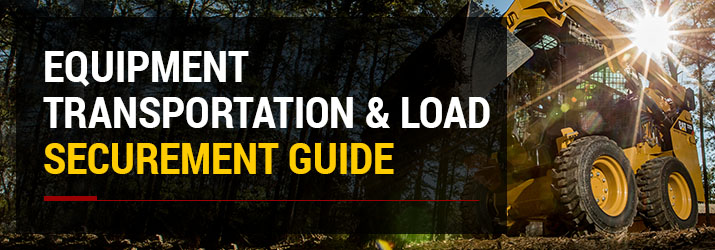
When you need to transport a piece of equipment to a job site, whether it’s just down the street or across the state, it’s important to consider the details. It’s easy for the focus in construction to be mostly on job site safety. Jobsite safety is very important, but loading, securing and unloading your construction equipment is equally important. Failure to fasten your equipment securely for transport can have significant consequences, including damage to the equipment and the vehicle you’re using to transport it, violation fines, out-of-service vehicles and even injury or death to the driver and others that could be involved in an accident.
Rather than take those serious – and expensive – risks in the interest of getting it done quicker or in the name of only transporting short distances, it’s important to make sure you know and follow all the federal and state rules that are in place for transporting equipment. It’s also important to be aware of all of your options. If you don’t have the resources to transport equipment properly, you can always hire a company that does.
Jump to Sections:
- Equipment Load Securement Guidelines
- Heavy Equipment Transportation
- 5 Most Common Equipment Transportation Violations
Equipment Load Securement Guidelines
If you’re transporting a piece of equipment or cargo, you get a trailer, load, fasten the equipment or cargo to the trailer and hit the road. Load securement is a blanket term that refers to all aspects of fastening that piece of equipment or cargo to the trailer. While the process of transporting equipment sounds straightforward, there are very specific rules for you to follow to make sure the piece of equipment or cargo arrives safely at its destination — and these rules are enforced.
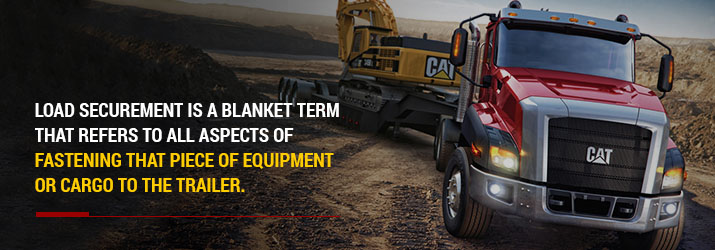
Load securement rules are enforced by the Department of Transportation (DOT) — more specifically, the Federal Motor Carrier Safety Administration, the federal government agency responsible for regulating and providing safety oversight of all commercial motor vehicles.
Before we get into the specific rules for transporting equipment, it’s important to understand a few key DOT definitions:
- Securement system — This is a group of individual parts that work together to secure equipment on a trailer. If the cab shield is providing some restraint against forward movement, it may be included. You can choose the combination of parts that work best for you if they are appropriate for the equipment size, shape, strength and characteristics. The most common parts of a securement system are:
- Floors
- Walls
- Decks
- Tie-down anchor points
- Headboards
- Bulkheads
- Stakes
- Posts
- Anchor points
- Securing device — These devices are designed specifically to hold your piece of equipment in place on a trailer or vehicle. They may include:
- Synthetic webbing
- Chain
- Wire rope
- Manila rope
- Synthetic rope
- Steel strapping
- Clamps and latches
- Blocking
- Front-end structure
- Grab hooks
- Binders
- Shackles
- Winches
- Stake pockets
- D-rings
- Webbing ratchet
- Bracing
- Friction mat
- Tie-down — A combination of securing devices that forms an assembly that attaches your piece of equipment to, or restrains it, on a vehicle — and is attached to anchor points.
- Working Load Limit (WLL) — The maximum load that may be applied to a component of a securement system during normal service. Each component should have a WLL from the manufacturer.
Heavy Equipment Transportation
The goal is to have all cargo — including heavy equipment — remain secured on or within the transporting vehicle. To do that, the DOT has developed a list of load securement rules. Some rules apply to all cargo, but there are also separate sections dedicated to additional requirements for specific types of cargo — like heavy equipment. There’s one section, in particular, specifically for equipment load securement. Section 3.8.1 of the Cargo Securement Rules apply specifically to the transportation of equipment that operates on wheels or tracks and individually weighs more than 10,000 pounds (4,500 kilograms).
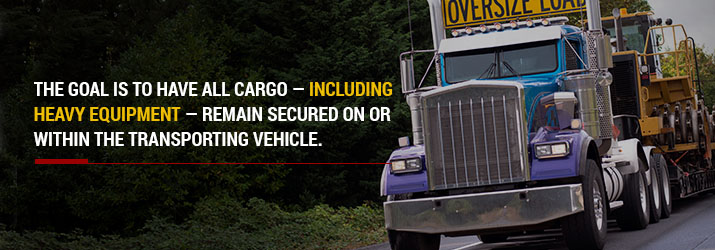
Between the rules for all cargo and those specific to heavy equipment transportation, the DOT has defined exactly what needs to be in place to ensure proper equipment load securement. We’ve included a summary of the main requirements below:
Know the dimensions and weight of your heavy equipment.
Knowing the weight of the piece of equipment you’re hauling is the first and most crucial step in equipment transportation. Almost all the rules for hauling equipment involve the weight of the piece of equipment, so it’s essential to have the exact dimensions and weight — not an estimate. These measurements will guide much of the process — especially when you combine them with the dimensions and weight of your vehicle and trailer to determine total dimensions and weight.
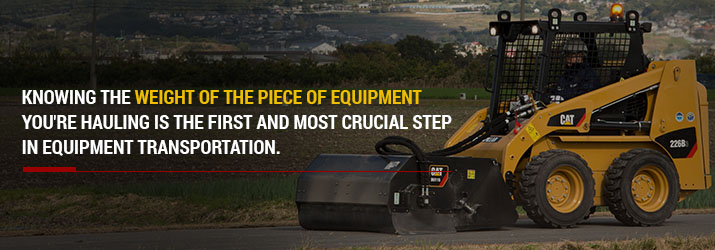
Verify whether you’ll need an oversized/overweight permit.
The information we’re providing is specific to heavy equipment that does not require a permit to transport. Remember, if you are carrying a significant piece of heavy construction equipment that requires a permit, you are subject to the standards in that permit. Those requirements for permit application and rules within the permit will vary to some extent from state to state. Per the Michigan Vehicle Code, for example, the business entity or individual transporting the equipment would need to apply for a permit if the vehicle exceeds:
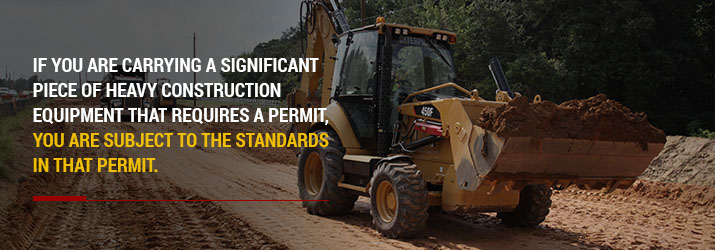
- 13 feet 6 inches tall
- 8 feet wide
- 50 feet long: semitrailer including load
- 59 feet long: combined semi-tractor-semi-trailer
- 80,000 pounds gross weight — subject to axle weights
An oversized/overweight permit comes with a specific set of restrictions for transporting equipment in Michigan.
In Indiana, you’re required to obtain an oversized or overweight permit if your vehicle exceeds:
- 13 feet 6 inches tall
- 8 feet 6 inches wide
- 60 feet long: two-vehicle combination
- 53 feet long: combined semi-tractor-semi-trailer
- 80,000 pounds gross weight — subject to axle weights
An oversized/overweight permit comes with its own set of restrictions for transporting equipment in Indiana — while some may be similar to other states, ultimately every state is different.
Be aware of the capacity of your trailer.
Once you’ve established the weight of the equipment you’re hauling, the next step is to use it to ensure you have the proper hauling equipment. Make sure your trailer capacity is appropriate for the piece of equipment you’re hauling and remember to take into consideration the weight of the trailer itself. It’s critical to transport your piece of equipment on a trailer that was designed to hold the weight of your cargo.
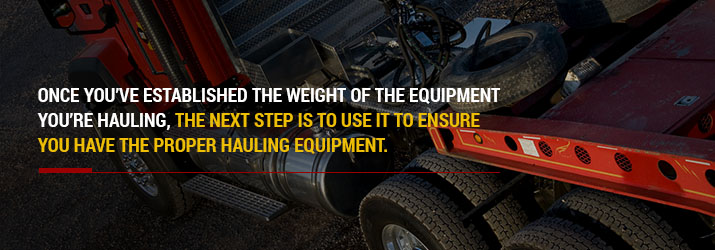
Take time to inspect your hauling vehicle, trailer and anchor points.
Once you’ve established the combined weight of the piece of equipment and the trailer are appropriate for the trailer size, you need to make sure the trailer, hauling vehicle and anchor points are in good shape — that means:
- No obvious damage
- No distress
- No weakened parts or sections
It’s also important to make sure the trailer and equipment are free of rocks and other debris. While it may not seem harmful sitting still, rocks that dislodge during travel can end up flying through the air and into someone’s vehicle. Checking for rocks and small debris may not seem like a big deal, but it can make a big difference.
Ensure loaded equipment will be contained, immobilized or secured.
In simplest terms, your piece of equipment cannot roll, tip, slide or fall from the vehicle during transportation. According to the DOT, you must secure your cargo in such a way that it will not blow off the vehicle, fall from the vehicle, become dislodged from the vehicle or shift to the extent that it adversely affects the vehicle’s stability or maneuverability.
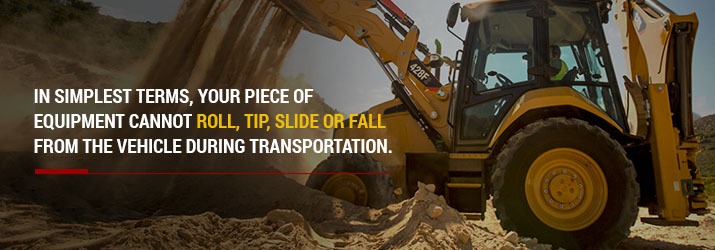
Develop a securement system plan that will properly distribute weight and can withstand the force requirements.
It’s time to review the rules so you can develop a securement system that will keep your equipment safe. Regardless of what system you put into place, it must be strong enough to withstand the following forces:
- Forward force: 80 percent when applying the brakes while driving
- Rearward force: 50 percent when speeding up, shifting gears or braking in reverse
- Upward force: 20 percent when navigating a bumpy road or climbing a hill
- Sideways force: 50 percent when executing a turn, making a lane change or braking into a turn
All percentages above are specifically the percent of the cargo weight.
Follow the DOT tie-down requirements.
In addition to being strong enough to withstand those forces, DOT tie-down laws state you’ll need to restrain your piece of heavy equipment with at least four tie-downs, each with a WLL of at least 5,000 pounds (2,268 kilograms). The golden rule in the DOT tie-down requirements is the sum of the WLL from all tie-downs must be at least 50 percent of the weight of the piece of equipment. If the sum of your four tie-downs doesn’t get you to that point, use as many tie-downs as needed to satisfy that requirement.
Whatever number of tie-downs you need for your equipment, you should attach them to the front or rear of the vehicle or the mounting points on the vehicle. Wondering exactly where to put them? Equipment manufacturers have designated tie-down areas, so you’ll need to familiarize yourself with the areas the manufacturer has designated, and you can rest assured you won’t do any damage to the piece of equipment using these tie-down points.
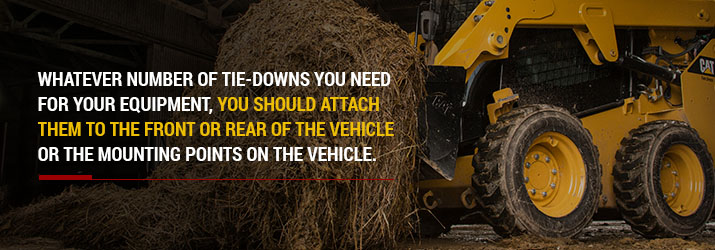
The purpose of a tie-down is to keep your piece of equipment in place during transportation, so it’s no surprise the DOT tie-down laws say each tie-down needs to be attached and secured so that it does not become loose, unfastened, open or release during transport.
Make sure you’re aware of the securement points on the piece of equipment you’re hauling. Trailers have easy-to-identify areas to attach tie-downs, but equipment can be tricky. Know the machine and where you can — and can’t — tie it down. You don’t want to end up damaging the equipment as you’re securing it for transport.
Confirm equipment loaded according to your securement system will not interfere with operation.
While these may seem like obvious statements, it’s important to be aware your piece of equipment must not obscure the driver’s view ahead, to the left or the right when loaded on the vehicle. It also cannot interfere with the free movement of the driver’s arms and legs, prevent the driver from being able to access any accessories he/she may need in case of an emergency or prevent the driver or passenger(s) from being able to exit the vehicle.
Lower and secure all vehicle and accessory equipment.
In addition to the rules regarding the securement system WLL and anchor points, you need to make sure all your vehicle’s structure and equipment are secured. You’ll want to check your tailgate, doors, tarpaulins, spare tires and any other equipment used in the vehicle’s operation — separate from your cargo piece of equipment.
Also, check any and all equipment accessories and work tools — think hydraulic booms, buckets, etc. — are lowered and secured. If the piece of equipment you’re transporting is an articulated piece of equipment, that needs to be restrained to ensure articulation will not occur during transit.
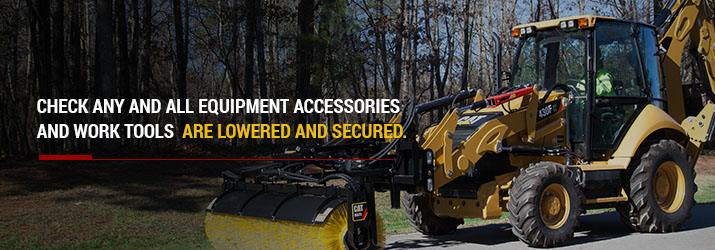
Apply the equipment’s parking brake.
Once you have a plan and are ready to load the equipment, make sure before you begin fastening the securement system that you set the parking brake on the equipment.
Review the DOT requirements for additional information.
There are additional guidelines for edge protection, blocking and bracing, to name a few. While we’ve given an extensive recap of the DOT equipment transportation laws, it’s important to review the DOT’s Driver’s Handbook on Cargo Securement. By reviewing this information, you can be sure you are following all the rules and guidelines that are in place to avoid a citation for a violation — or worse, an accident.
When you’re following the rules, damage can still occur — if you want to know how to avoid damage in equipment transportation, that’s even more reason to review the DOT Driver’s Handbook on Cargo Securement.
5 Most Common Equipment Transportation Violations
Each year, the Commercial Vehicle Safety Alliance (CVSA) conducts an International Roadcheck in the United States and Canada. During this three-day event, CVSA-certified inspectors gather to conduct a high number of roadside inspections of large trucks and buses within a 72-hour timeframe.
During the 2017 International Roadcheck, the CVSA placed 23 percent of the vehicles that had level-one inspections — a 37-step procedure that covers driver and vehicle — out of service. One of the top three reasons why? Cargo securement violations.
In any cargo securement violation, the CVSA will both levy fines and take vehicles out of service. Often, fines are for both the driver and the company that is hauling. In addition to these financial penalties, your Compliance, Safety and Accountability rating with the DOT goes down, as does the driver’s record.
What are the most common violations? And how can you be sure you aren’t in violation as you transport equipment?
1. No Improper Load Securement
If you get cited for “no or improper load securement,” chances are you failed to secure your load altogether or did so without meeting the minimum DOT requirements. The violation would include the vehicle being out of service, in addition to any applicable fines.
Improperly secured cargo can lead to accidents that can damage your equipment and vehicle as well as injure your driver — and that’s just if your vehicle is the only one involved. Any piece of equipment that may shift or fall as a result of not being secured properly could cause other vehicles to swerve, causing an accident.
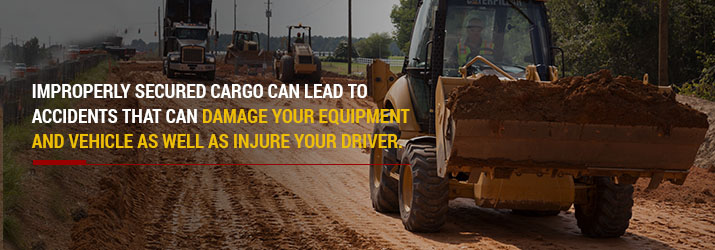
2. Failure to Secure Vehicle Equipment
While our focus has primarily been on the piece of equipment you’re transporting — your cargo — but it’s equally important to make sure your vehicle’s equipment is secure when you’re hauling cargo. Think about things like your tailgate, doors, tarpaulins, spare tires and any other equipment that may be part of your vehicle and need to be secured. If you secure the piece of equipment properly, but fail to secure some part of your vehicle, you could still have your vehicle taken out of service and/or cause an accident as a result of a loose part of your vehicle.
3. Leaking, Spilling, Blowing or Falling Cargo
If your equipment falls off the vehicle, or a substance from the equipment spills onto the roadway, you would be cited for this violation. In addition to having the vehicle placed out of service, the damage caused to your equipment, vehicle and people as a result of this violation add up — and that’s not even taking into consideration the amount of the fine. By following the rules, you can ensure your securement system will not allow this movement to happen.
4. Insufficient Tie-Downs to Prevent Forward Movement
The DOT tie-down laws are straightforward. If you don’t follow them, you’ll likely be cited for this insufficient tie-down violation — which has the potential to lead to others if your load isn’t secured properly. Forward movement or force is important because it can have an impact on your vehicle’s brake system. If you need to make a stop and the piece of equipment isn’t tied down properly to reduce forward motion, you’ll have additional force in forward motion, which could prevent you from stopping at your regular interval. This inability to stop can cause expensive accidents and damage to your vehicle and cargo, as well as other vehicles. Your vehicle will be labeled out of service, too.
5. Failure to Secure Load
If you fail to secure your load, you’re putting yourself, and others on the road, in danger. Shifting cargo can cause accidents that result in injury or death. As with many of these other violations, if you get cited for this violation, your vehicle will be put out of service, and the driver and company will have to pay the fines that come with these violations.
All these violations have one thing in common: They are easy to prevent. As long as you follow the DOT laws related to transporting cargo, you eliminate the risk not only of being cited for one of these violations, but also the risk of accidents and other damage that can occur as a result of cargo not being securely fastened.
You want to make sure you’re not missing anything when it comes to your equipment load securement. To avoid these and other violations — or worse, an accident — make sure you understand the DOT rules and have the right equipment. If you don’t have the proper hauling equipment or feel unsure of meeting all the requirements, MacAllister Rentals offers a couple of different options to help equipment haulers in Indiana and Michigan.
If you have a truck but need a specific trailer, you can rent one from a MacAllister Rentals location in Indiana and Michigan. If you need equipment delivered, we have a selection of rental equipment we can deliver and pick up from your job site — so you don’t have to worry about any of the equipment transportation. If you aren’t exactly sure what you need or have questions about rental equipment and equipment transportation, we’d be happy to help — contact us today.
*Disclaimer: This information is not provided by legal professionals and is intended only to complement, and not to replace or contradict, any local, state, or federal laws or information provided by legal professionals. The information and recommendations covered in this resource do not necessarily reflect those of MacAllister Rentals and/or its affiliates. If you have any questions, please consult your local laws, company policies, or contact a legal professional.
